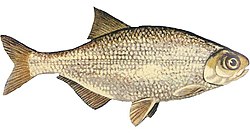| Hyperopisus | |
|---|---|
 | |
| Hyperopisus bebe (below), Mormyrops anguilloides (above) | |
| Scientific classification | |
| Kingdom: | Animalia |
| Phylum: | Chordata |
| Class: | Actinopterygii |
| Order: | Osteoglossiformes |
| Family: | Mormyridae |
| Genus: | Hyperopisus T. N. Gill, 1862 |
| Species: | H. bebe |
| Binomial name | |
| Hyperopisus bebe (Lacépède, 1803)
| |
Hyperopisus is a monospecific genus of freshwater ray-finned fish belonging to the family Mormyridae, the elephantfishes. The only species in the genus is Hyperopisus bebe. [2] This species is known from many rivers in the northern half of Africa, ranging from the Senegal to the Nile basin. [3] It reaches a length of 51 cm (20 in). [3]



